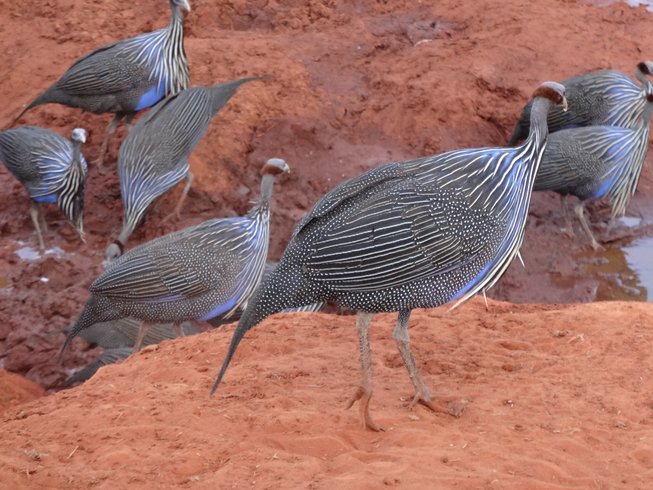Tsavo East and Tsavo West National Parks together make up the biggest national park in Kenya at just under 22 000 sq km. In May 1948, a month after the park’s conception, Tsavo National Park was divided into east and west for administrative purposes. Named after the Tsavo River which flows from west to east, the park is considered one of the world’s biodiversity strongholds. Tsavo East National Park is one of the oldest and largest parks in Kenya at 13,747 km2. Situated in a semi-arid area previously known as the Taru Desert it opened in April 1948, and is located near the town of Voi in the Taita-Taveta County. It is particularly well known for its large herds of elephants and captivating landscapes. Tsavo is one of the less populated game areas in Kenya and is perfect for those who want to enjoy a pristine wildlife experience.
The national park is comprised of grasslands and savanna and riverbeds created by the Tsavo and Athi rivers which combine into the Galana River. Collectively, they create one of the richest biodiverse areas of Africa with an abundance of wildlife.

Tsavo East is the only Kenyan park that permits night drives. It is a vast park and guests will often have to be patient during game viewing activities, but the reward is great. The experienced safari guides are familiar with the game movements and season migration paths and times of Tsavo’s wildlife. Some of Tsavo East’s popular attractions are Mudanda Rock, Yatta Plateau and Lugard Falls.
The surface of this part of Tsavo is essentially flat and covered with low, dry vegetation. The reserve is popular for short safaris from the Kenya coast, such as Mombasa, which makes for a stunning East Africa beach and bush vacation.
How to get there
By Air: Tsavo East National Park has several Airstrips: Vio, Aruba, Satao, Sala, Ithumba, Sangayaya, Mopeo ,Bachuma and Cottars.
By Road: The park’s Mtito Andei Gate is 233 km South of Nairobi and 250 km North of Mombasa on the main Nairobi- Mombasa Road.
Distance Nairobi-Mtito Andei: 233 km – Mtito Andei-Voi: 96 km – Voi-Mombasa: 153 km. From Malindi, take the western road (C103) and enter in the park via Sala gate.
What to see and do
Tsavo East is generally flat with dry plains across which the Galana River flows. Feature attractions include the Yatta Plateau, Lugards Falls, Mudanda Rock and Aruba Dam. The water features in Tsavo offer an oasis-like appeal to the park and keep the wildlife present.
The most sought after species are hirola antelope, mongoose, giraffe, bat-eared fox, hyrax, Grevy’s zebra, ground pangolin, Sykes’s monkey, black-faced vervet monkey and dik dik, to name but a few. Over 500 species of bird have been recorded in the area, including ostrich, kestrel, starling, weaver bird, kingfisher, buzzard, hornbill, secretary bird and heron.
Tsavo lions are historically famous for not having manes (even the males), and as a result of this uncommonness, many lions have been hunted and killed in Tsavo. Kenya has banned hunting for many years now, but the closeness of Kenyan villages to its game reserves means that human-wildlife conflict has to be carefully managed.
Climate
Kenya lies across the equator, and Tsavo East National Park is just a few degrees latitude south. The temperature is fairly constant year round, but the rainfall varies. The tropical temperature ranges from 27-31°C (81-88°F) in the daytime and 22-24°C (72-75°F) at night. The long rainy season in Kenya lasts from March to May and the rainfall is heavy, making this a bad time for wildlife safaris.
The short rainy season lasts from October to December, but the weather during this period is still good enough to go on safari – just expect some afternoon showers. The humidity is high from December through April.
